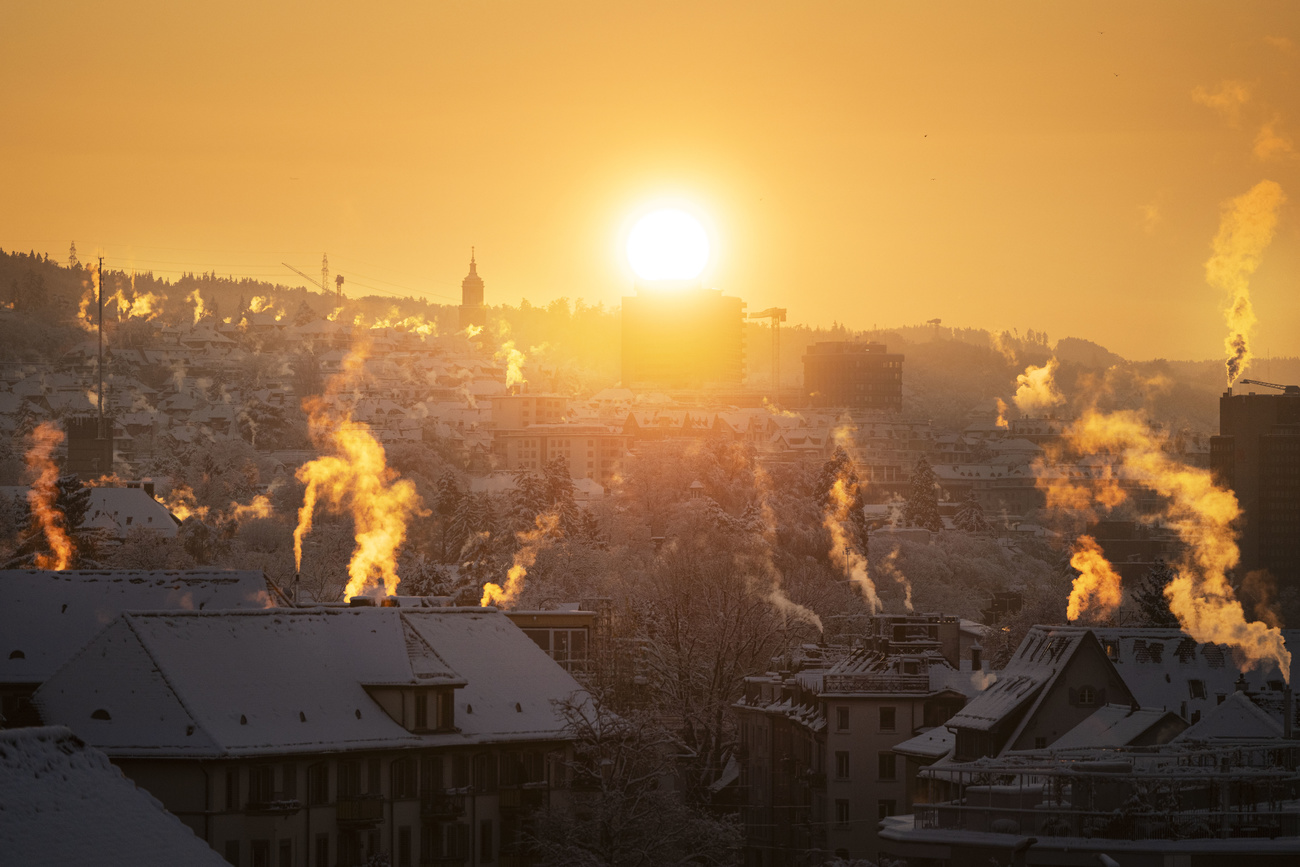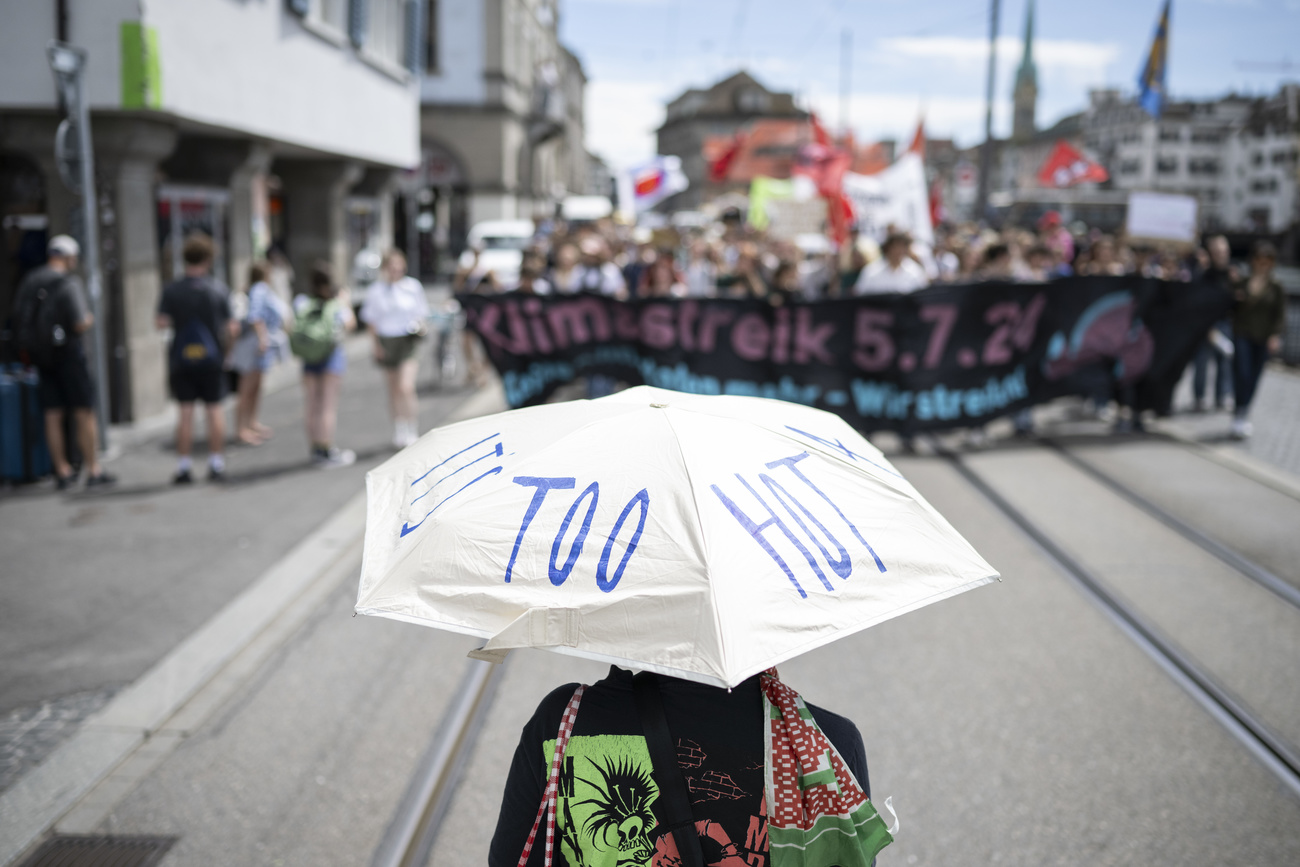Switzerland’s new 2035 climate goals disappoint

The Swiss government has set new 2035 greenhouse gas emissions targets as part of its international commitment to combat climate change. But environmental groups and observers are unimpressed, calling them inadequate.
“By 2035, Switzerland should reduce its greenhouse gas emissions (GHG) by at least 65% compared to 1990 levels, and by 59% on average between 2031 and 2035,” the government announcedExternal link on Wednesday.
Switzerland had previously committed to cutting GHG emissions by 50% by 2030 from 1990 levelsExternal link. The new objectives, known in UN jargon as nationally determined contributions (NDCs)External link or ratcheted-up climate reduction commitments to the landmark 2015 Paris Agreement, are to be primarily achieved via domestic climate measures.
The authorities said the new NDCs are “more stringent than in the previous period between 2021 and 2030” and are in line with the interim targets defined in the Swiss Climate and Innovation ActExternal link and its net-zero target by 2050External link. They also correspond to the recommendations of the Intergovernmental Panel on Climate Change (IPCC).External link
Switzerland plans to submit its new NDCs to the United Nations Framework Convention on Climate Change (UNFCCC) by February 10, where they will be recorded in a UN global registryExternal link. Under the Paris Agreement states agreed to submit more ambitious targets every five years; the last were filed in 2020. They will be reviewed and discussed by experts and ministers at the COP30 climate talks in November in Brazil.
Lacking ambition and fairness
Although Switzerland is one of the first states to hand in its climate homework, Swiss environmental groups remain unconvinced by the updated strategy.
Patrick Hofstetter, a climate expert at WWF Switzerland, said it lacks the necessary ambition.
“The target adopted is certainly close to the CO2 reduction trajectory defined as the global average by the IPCC. But as a wealthy industrial country with great responsibility and corresponding opportunities, Switzerland’s fair share would be significantly higher, and this is precisely what Switzerland committed to in the Paris Agreement,” he declared.
Signatories to the landmark climate accord agreed to follow the principle of equity and “common but differentiated responsibilities” in the fight against climate change, based on differing national circumstances like wealth.
Hofstetter believes it’s possible to completely phase out fossil fuels in Switzerland by 2035, which could reduce its GHG emissions by 80%.
‘Abandoning’ 1.5°C limit
Greenpeace, meanwhile, accusedExternal link the government of abandoning the crucial 1.5°C global warming limit set under the Paris accord.
Under its proposed strategy, Switzerland will take too large a share of the carbon budget still available to the planet, “at the expense” of poorer countries, said Georg Klingler of Greenpeace Switzerland, who estimated that the government should aim for an 87% CO2 reduction target for 2035.

More
Government estimates for first time Switzerland’s carbon budget up to 2050
Greenpeace said the new targets and Swiss position clearly ignored last year’s landmark climate verdict by the Strasbourg-based European Court of Human Rights (ECHR) in the KlimaSeniorinnen caseExternal link. The court had ruled that Switzerland was not doing enough to tackle climate change.
Klingler pointed to countries such as Denmark, which plans to reduce its own emissions by 70% by 2030, as proof that it is possible to do more.
International comparisons
In an international climate-policy comparison ranking published by the Climate Change Performance Index (CCPI) last November, Switzerland fell 12 places to 33rd placeExternal link due to researchers’ perception of a “standstill” in Swiss climate policy until 2030.

More
Switzerland plummets in climate protection ranking
The Climate Action Tracker (CAT),External link a Berlin-based independent group monitoring climate policy around the world, also rated Swiss climate action and progress as “insufficientExternal link” last year.
CAT analyst Judit Hecke told SWI swissinfo.ch that closer analysis was required but Switzerland seemed to have “missed the opportunity to strengthen its already insufficient’ 2030 target”, meaning that even greater efforts will be required to try to reduce GHG emissions to meet its long-term climate goals beyond 2030.
And while the government says the objectives will be achieved “primarily through domestic measures,” it once again fails to specify the exact share of domestic reductions versus reliance on international carbon credits, she said.
“Switzerland appears to be continuing its approach of offsetting emissions abroad – a strategy we have previously criticised,” said Hecke.
Biden’s plans may unravel
A handful of countries have also submitted updated NDCsExternal link ahead of a spring deadline, including the United Arab Emirates, Uruguay, Brazil and the United States.
Former US President Joe Biden’s administration unveiled an ambitious new climate target just weeks before Donald Trump’s recent return to the White House. The plan commits the US to cutting gas emissions by 61-66% below 2005 levels by 2035, on the path to achieving net zero by 2050.
While Biden made climate change a hallmark of his administration and some of his policies remain, Trump is swiftly unravelling that, even though many of his decisions are likely to be challenged in court.
Trump signed an executive order on January 27 instructing the US to again withdraw from the Paris climate agreement. This means the federal government won’t be trying to meet emissions reductions goals or any financial commitments to the UNFCCC.
Canada also has a new target to cut its emissions to 45-50% below 2005 levels by 2035. A statementExternal link said the pledge would be submitted to the UN in 2025.
Major polluters China, India and Russia have yet to announce their NDCs.
Meanwhile, the European Union – the world’s fourth-largest emitter – is considering a 90% reduction by 2040 from 1990 levels but has yet to submit its updated plan.
Alarming climate reports
The Paris Agreement requires all countries to take steps to reduce their greenhouse gas emissions, aimed at limiting global warming to 1.5°C since pre-industrial times, or to well below 2°C. Already the long-term global average temperature rise is at least 1.1°C, according to a report by the IPCC body of scientists.
But on January 10 Europe’s Copernicus observation agency confirmed that 2024 was the hottest year on record, with average surface temperatures 1.6°C above pre-industrial levels.
This was the latest in a series of alarming climate reports. Last November the UN Environment Programme (UNEP) Emissions Gap Report 2024External link said the world was on course for a “catastrophic” rise of more than 3°C by the end of the century, and that the ability to remain with the target of 1.5°C of global warming “will be gone within a few years” without rapid action.
The UNEP authors warned of a “massive gap between rhetoric and reality”. Emissions are not going down fast enough and nations – especially the G20 countries responsible for almost 80% of global emissions – need to be much more ambitious and make “dramatically stronger” pledges to close the huge emissions gap.

More
Why Switzerland’s carbon footprint is bigger than you think
Edited by Virginie Mangin/gw

More
Newsletters

In compliance with the JTI standards
More: SWI swissinfo.ch certified by the Journalism Trust Initiative









You can find an overview of ongoing debates with our journalists here . Please join us!
If you want to start a conversation about a topic raised in this article or want to report factual errors, email us at english@swissinfo.ch.